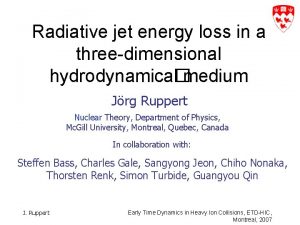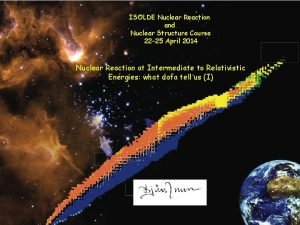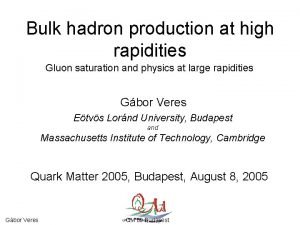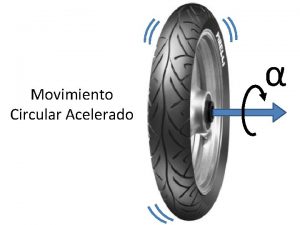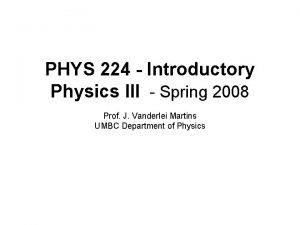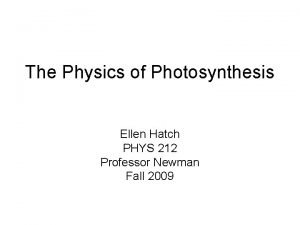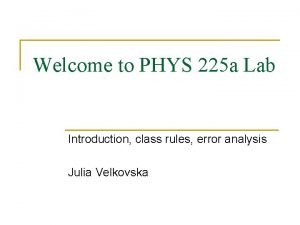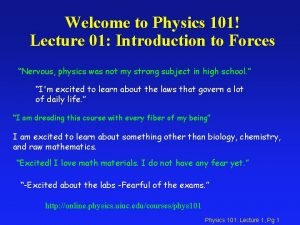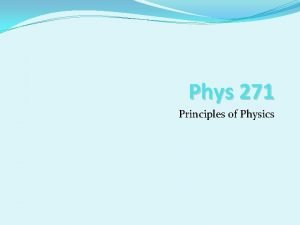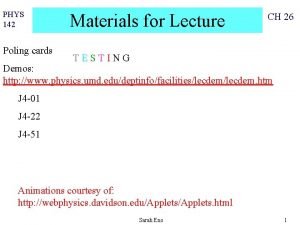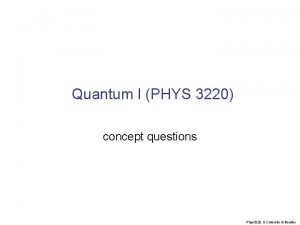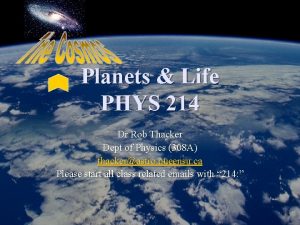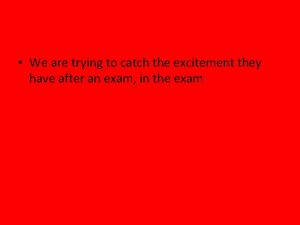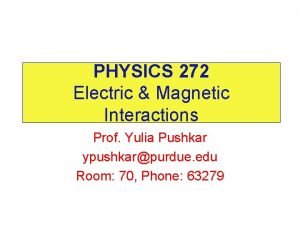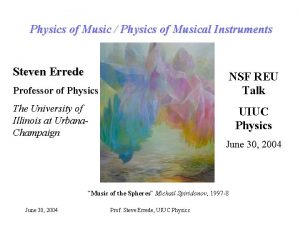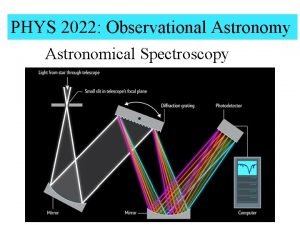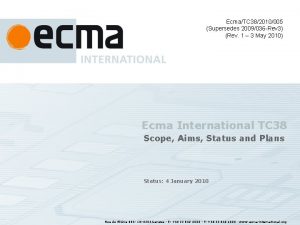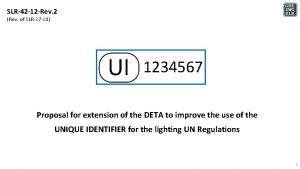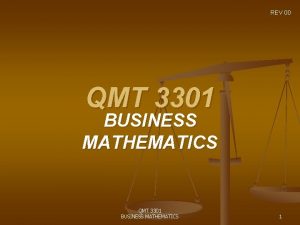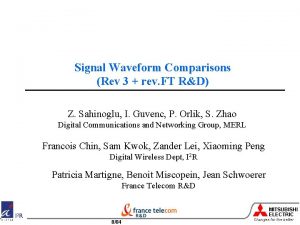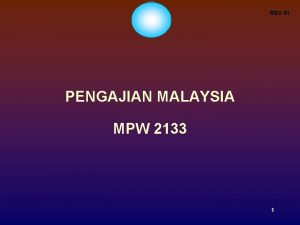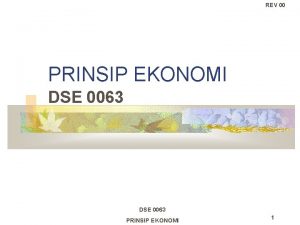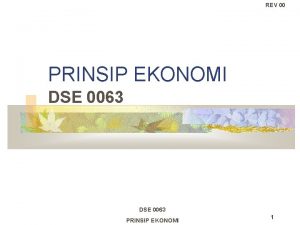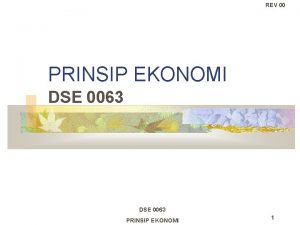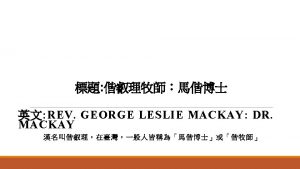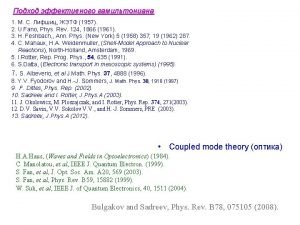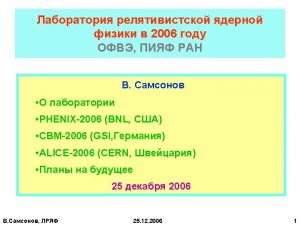CenterSymmetric 1N Expansion Phys Rev D 71 105012



















- Slides: 19

Center-Symmetric 1/N Expansion Phys. Rev. D 71, 105012 (hep-th/0410254 v 2) Outline : • A center-symmetric background at finite temperature • ‘t Hooft diagrams and U(N) at large N (essentials). • Confinement and the free energy at large N. • The center-symmetric perturbative expansion at large N -Composite loop momenta -Background gauge + perturbative renormalization -1 -loop contribution to the free energy -no O(N 2) nor O(N) contributions to the free energy -absence of (severe) perturbative IR-divergences -confinement at weak coupling • Outlook

The center-symmetric vacuum Center-symmetric expansion Lattice center-symmetry: center-symmetric “ground” state Contractible Wilson loops (including plaquettes) are invariant (they contain pairs of oppositely oriented links of the slice) [contraction on lattice: generated by for instance: ] But (non-contractible) Polyakov loops of non-vanishing N-ality are sensitive to the center symmetry:

Center symmetric orbit Under gauge trafo: Use gauge freedom to diagonalize ALL U’s and order the eigenphases: independent of x! Center-symmetric orbits in this gauge have constant Abelian temporal links, i. e. correspond to a constant temporal Abelian connection: Since none of the eigenphases of a center-symmetric orbit are degenerate, the gauge transformation g(x) is unique up to Abelian gauge transformations. Spatial links further specify the configuration there are MANY centersymmetric orbits.

Perturbatively (near the critical point of LGT), one is interested in a centersymmetric orbit of minimal classical (Wilson) action, i. e. vanishing curvature: All links are Abelian AND constant in each spatial direction For a spatially cubic lattice (i. e. the lattice analog of ), the center-symmetric orbit with vanishing Wilson action is unique (there are no non-contractible spatial loops in this case. ) Proofsketch: Make all temporal links=1 except for those on slice. Vanishing Wilson action spatial links do not depend on . On the slice we then have spatial link Abelian temporal link on same spatial link or: slice Since none of the phases of are degenerate, is Abelian as well. Consider therefore the perturbative expansion of [S]U(N) gauge theory about the center-symmetric background connection.

‘t Hooft diagrams j i k l i j l k j etc. mn Color loops are FACES, gluon propagators are EDGES, vertices are VERTICES and fundamental loops are HOLES of oriented complexes: i

determined by topology of vacuum diagram In the usual perturbative analysis with broken center symmetry, the ground state does not depend on N. Absorbing traces over color in the definition of the ‘t Hooft coupling, vacuum diagrams of leading order in N have the topology of. Since , such planar contributions to the free energy are of order N 2 !!! Factorization: non-trivial multiplets contribute NON-CONFINING PHASE BUT: Dyson-Schwinger equations for Wilson loops + factorization free-energy does not depend on T (Gocksch+Neri 1983)

How are these Statements Compatible? Dyson-Schwinger equations respect symmetries consider perturbative contributions to the pressure at finite T for a center-symmetric background. Use the center-symmetric background for the background gauge field i. e. extremize - suitable for perturbative analysis; - background does not renormalize ALL (charged) FIELDS COUPLE COVARIANTLY TO ga NOTE: The Matsubara frequency and the color appear in the combination only. The “composite” Matsubara frequency runs over ALL integers iff color- and momentum- loops coincide – the effective temperature in this case is not T, but T/N.

Color- and momentum- loops coincide for planar diagrams (with and without perimeter ): Perimeter contributes a factor of N By dimensional analysis, BEFORE evaluating the (divergent) loops

Regularization and Renormalization Since the pressure superficially is quartically divergent, summations and integrals must be regularized gauge invariantly. Because, it suffices to regulate and renormalize the superficially quadratically divergent specific heat capacity at constant volume. This may be achieved by dimensional regularization and renormalization of spatial loop momenta only. For spatial dimensions, the renormalized planar contributions to the free energy density scale as is the dimensionless ‘t Hooft coupling; is the renormalization point, a (spatial) momentum scale that should not depend on N. Large N Large , i. e. weak coupling

Non-planar Contributions to the Pressure Question: are non-planar contributions to the pressure also suppressed? Answer: No, because Implies that there are MORE momentum- than color- loops. The two cannot be combined to a composite momentum. Only contributions with a toroidal or cylindrical topology survive the large N-limit. The summations over color in this limit can be replaced by integration over a Brillioun momentum the N-dependence is fully absorbed in the ‘t Hooft coupling – and the diagram nevertheless remains T-dependent, due to an extra momentum loop. Lowest perturbative order are the paperclip + rings:

Absence of IR-divergences Linde 1980: contributions of vanishing Matsubara frequency scale as 1 2 r perturbative QCD at finite temperature is plagued by uncontrollable IRdivergences for >3 loops. Pisarski et al: Consider “hard thermal loops” only. There are NO such IR-divergences in a center-symmetric background: Infrared-singular perturbative modes are Abelian (a=b). Abelian dominance? Abelian modes do not interact directly – perturbative IR-divergences therefore at most logarithmic and (probably) cancel in physical S-matrix elements (a la Kinoshita et al. ).

1 -loop Free Energy Eigenvalues of : = 2 N 2 bosons + 4 NF fermions but at temperature T/N !

A more careful calculation indeed gives: bosons suppressed as before fermions Effectively rather heavy at large N ! Non-planar contributions to the free energy of order N 0 are far more important. The Gluonic Center-Symmetric Planar Model is UNSTABLE at large N: The free energy of U(N) includes a decoupled “photon”: It must (at least) include the contribution from a vector ghost that compensates the contribution of this “photon” to the free energy of U(N) at large N. Could this be Veneziano’s vector ghost? ?

Perturbative (In)Stability and the Hessian The 1 -loop Hessian at the center-symmetric configuration (CS) is: Planar i j + i Nonplanar ! j With EV’s: 0, and All EV’s are negative – the CS-background maximizes the 1 -loop free energy The N-1 tachyonic modes are Abelian and have masses: But the CS-planar model is TACHYON-FREE and perturbatively stable at any temperature the phase transition in this case is first order.

Confinement at Weak Coupling? A non-trivial large-N model that confines at weak coupling is obtained by modifying the Wilson action to Since adjoint Polyakov loops , the CS-phase of this (renormalizable) model is perturbatively stable for Z(N) unbroken are conserved, CS-symmetric “charges” : Broken Z(N) 0

Note: For SU(2) & SU(3) only k=1 need be considered. The phase transition at is of second order for SU(2). But (at ) the phase transition is of first order for SU(3). The CS-symmetric phase also is perturbatively stable for : • [ adjoint fermions and even N and is N=1 SYM ] (See Hosotani) Large N Mass gap? !

Highlights § A diagrammatic expansion about a center symmetric orbit of U(N) gauge theory § is possible at finite temperature without additional technical difficulties. § at large N gives no contributions of O(N 2) and O(N) to the free energy. § does NOT describe a conventional Higgs phase because there are no colored asymptotic states at any order in perturbation theory. § avoids the severe infrared problem of ordinary perturbation theory. § A U(N) model defined by the PLANAR diagrams of the perturbative expansion about the CS-orbit at finite temperature § has a Matsubara frequency spacing of reduction similar to Eguchi-Kawai models. , i. e. exhibits dimensional § confines, but is purely topological with contributions to the free energy of order 1/N 2. [leading O(1) contributions of U(N) gauge theory arise from toroidal & cylinder diagrams. ] § is perturbatively stable and tachyon-free. § in the purely gluonic case includes a (perhaps decoupled) vector ghost.

Coupling of Tachyonic Modes To leading order N 0 , the non-planar polarization of order contributions of the form gives 1 PR that apparently resum to a tachyonic Abelian gluon mass of. However, this resummation is not gauge invariant ! To conclude that the Abelian gluons are tachyonic is premature.

Outlook Stability: Can one estimate the (torus+cylinder) contributions of order to the pressure? To leading order it is suffices to replace summations over color by Brillioun-zone integrals – all loops apart from one do not depend on temperature! Mesonic contributions Glueball contributions S SB and anomalies: For fixed T but large N, the “free” center-symmetric Dirac-operator has a (much) denser spectrum with a lowest frequency of rather than. At large N one effectively has a 3 -dimensional action for low-frequency Dirac modes…. .
